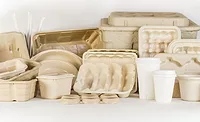Sustainable Packaging
Promoting Food Safety and Sustainability through Organic Food Packaging

As global awareness about health and environmental impact grows, the demand for organic foods continues to rise. However, to truly resonate with organic-conscious consumers, it’s important for businesses to not only focus on the quality of their organic produce but also on the sustainability and safety of their packaging solutions.
With Organic September upon us, I delve into the pivotal facets of organic packaging. By adhering to these principles, businesses can uphold the highest standards and ensure the safety of their products for customers.
Meeting Stringent Regulatory Standards
When it comes to packaging organic foods, strict adherence to USDA requirements is non-negotiable. Not only must materials and processes align with these requirements, but the packaging facility itself must be USDA inspected and certified to handle organic foods.
In the realm of organic packaging, materials and techniques must seamlessly harmonize with the organic content and handling prerequisites. An example lies in the use of preservatives and additives; only those enlisted in the National List of Allowed and Prohibited Substances can be employed for coloring, preserving or flavoring organic foods, and even then their usage is often limited to specific applications.
Furthermore, packaging materials must steer clear of any substances that are not on the allowable substances list, including preservatives, fungicides, fumigants and pest control compounds. This uncompromising approach ensures that the integrity of organic foods is maintained from production to consumption.
Optimal Material Selection
While EU regulations dictate that substances intended for food contact must not release harmful chemicals into consumables, there's still room for more robust measures. An illustrative case involves single-use plastics, which, though permitted, can transfer phthalates to food upon contact and exposure to heat.
Selecting suitable materials for organic packaging demands a discerning approach. Choose options that minimize the presence of unwanted chemicals while upholding organic and sustainable principles. Materials like compostable plastics, plant-based fibers and paper offer a natural breakdown without leaving behind harmful residues. Glass and metal containers, which are highly recyclable and chemically inert, limit interactions with the packaged goods.
Steer clear of some conventional plastics, as they can harbor hazardous additives like phthalates and bisphenol-A. Instead, explore alternatives like biobased plastics or cellulose-based materials. It's important to note that while aluminium is recyclable, certain aluminum-coated packaging materials may contain additional coatings that clash with organic principles.
Labeling, Transparency and Traceability
Packaging for organic foods should provide consumers with accurate and transparent information regarding the product's organic status and attributes.
Clearly labeling products as "Organic" or "Certified Organic" on the front of the packaging is a simple yet effective step. Display the logo or seal of the organic certification body that has verified compliance with organic standards. Including the certifying agency's name, along with relevant certification numbers or codes, further reinforces the authenticity of an organic claim.
Amp up transparency by assigning a unique traceability code to each product. This code enables consumers to access comprehensive information about the product's journey from source to shelf, fostering a sense of connection and trust. Incorporating transparent windows or panels into the packaging enhances visibility, particularly for consumables like food, cosmetics and personal care items.
To provide real-time indicators of a product's condition, consider introducing color-changing labels based on factors like freshness, temperature or ripeness.
The Pursuit of Sustainability
In the pursuit of sustainable packaging for organic fresh produce, several factors must be weighed. Sensitivity to moisture, air circulation requirements and expected storage duration are critical considerations. Additionally, the selected materials must align with organic and environmental certifications.
Biodegradable plastics derived from plant-based sources like cornstarch, potato starch or sugarcane offer a viable solution for short-term storage of fresh produce. These materials break down more readily in the environment compared to conventional plastics.
Opting for unbleached or recycled paper packaging presents another sustainable avenue. Such packaging not only provides protection and breathability but is also compostable or recyclable. For instance, moulded pulp trays crafted from recycled paper or agricultural waste offer cushioning and safeguard delicate produce like berries or eggs.
Lightweight mesh or net bags, made from natural fibers, facilitate air circulation and visibility, making them apt for items like onions, garlic or citrus fruits. Certain plant-based films, like those composed of cellulose or seaweed, are breathable and extend the shelf life of produce while remaining environmentally friendly.
Ultimately, the core objective of these innovative packaging strategies is to empower consumers with comprehensive information. By cultivating trust and promoting conscious purchasing decisions, these practices pave the way for a healthier, more sustainable future.
Looking for a reprint of this article?
From high-res PDFs to custom plaques, order your copy today!








